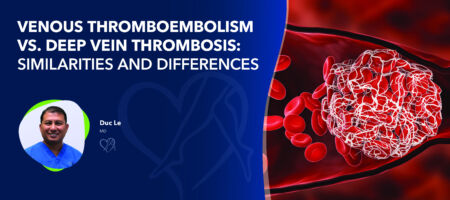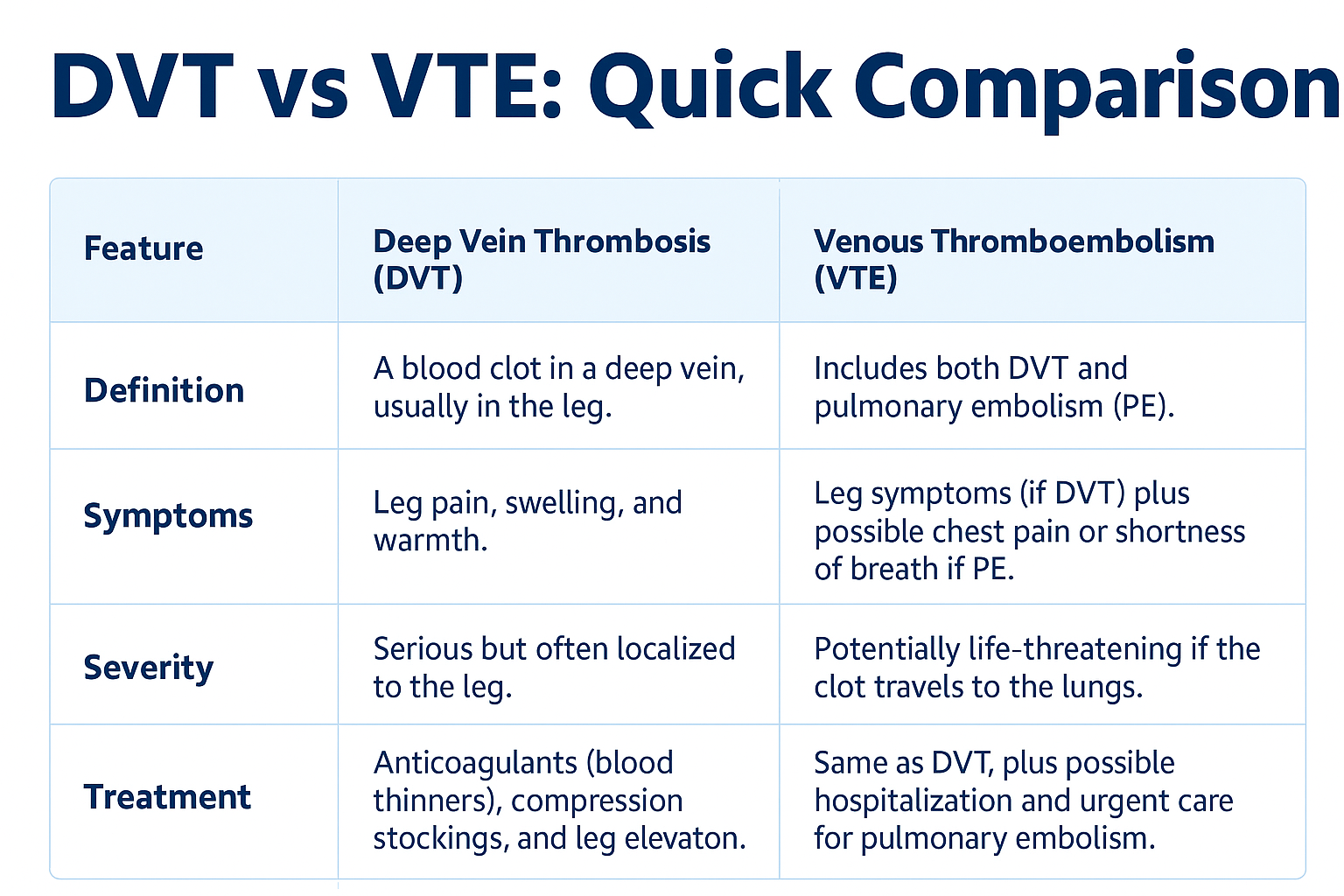
Medically reviewed by Duc Le, MD, on November 3, 2025
It’s understandable to confuse the terms venous thromboembolism (VTE) and deep vein thrombosis (DVT). They look and sound similar, and both involve blood clots that form in the veins. However, these conditions are not identical. Knowing the difference is vital because each carries different levels of risk and urgency.
We consulted with a board-certified Center for Vein Restoration vein physician, Dr. Duc Le, lead vein physician at Center for Vein Restoration (CVR) vein clinics in Frederick, Maryland, and Hagerstown, Maryland, to help us understand how DVT and VTE symptoms overlap and differ. This information will help you recognize the signs early and get the right care at the right time to keep you safe.
📅Schedule a consultation with Dr. Le in Frederick, Maryland: CLICK HERE
📅Schedule a consultation with Dr. Le in Hagerstown, Maryland: CLICK HERE
📞Prefer to talk to a Patient Services Representative first? Call 240-249-8250
Deep vein thrombosis (DVT) occurs when a blood clot forms in a deep vein, most often in the legs. These veins carry blood back to the heart, and a clot can block this flow, leading to symptoms such as leg pain, swelling, redness, and warmth.
According to the Cleveland Clinic, DVT most commonly develops in people who are inactive for long periods, such as after surgery, during a hospital stay, or even on long flights. Other risk factors include obesity, pregnancy, smoking, older age, and certain genetic clotting disorders.
If left untreated, DVT can lead to serious complications. The most dangerous occurs when part of the clot breaks off and travels to the lungs, causing a pulmonary embolism (PE), a life-threatening emergency.
Venous thromboembolism (VTE) is a broader term that includes both DVT and pulmonary embolism. In other words, every DVT is a form of VTE, but not every VTE is limited to the leg. When a clot dislodges from a deep vein and travels to the lungs, it becomes a pulmonary embolism. This can block blood flow, causing chest pain, shortness of breath, and in severe cases, sudden collapse.
VTE is one of the leading causes of preventable hospital deaths worldwide, according to the National Library of Medicine (NIH). Because DVT can silently progress to VTE, prompt recognition and medical evaluation are essential.
DVT and VTE share the same fundamental cause: a blood clot forming within a vein. The underlying mechanism involves slow or stagnant blood flow, vessel injury, or an increased blood clotting tendency.
Common risk factors include:
Typical symptoms, such as leg pain, swelling, tenderness, and warmth, occur because the clot blocks normal circulation. In some cases, the skin may appear red or discolored, or the leg may feel heavy. These symptoms can mimic other vein problems, which is why evaluation by a vein expert is vital.
Below is a quick comparison chart to see the similarities and differences at a glance:

It’s important to distinguish clot-related conditions like DVT and VTE from chronic venous insufficiency (CVI) and varicose veins, which are other common forms of vein disease.
CVI occurs when the tiny valves inside your leg veins weaken or fail, allowing blood to flow backward and pool in the legs. This leads to swelling, leg heaviness, aching, and the visible twisting of varicose veins.
While CVI and DVT are distinct conditions, they can be connected. According to Penn Medicine, a past DVT or other clot can damage vein valves, increasing the likelihood of developing chronic venous insufficiency later.
Similarly, untreated CVI may cause vein wall inflammation, raising the risk of clot formation. That’s why it’s essential to have leg pain, swelling, or visible vein problems evaluated by a board-certified vein specialist.
At Center for Vein Restoration, our experts diagnose and treat the full spectrum of vein disease, from cosmetic varicose veins to serious deep vein disorders, using advanced, minimally invasive outpatient vein treatments designed to restore healthy circulation.
📞 Call Center for Vein Restoration at 240-249-8250
📅 Or book online HERE
Prevention focuses on improving circulation and reducing clot risk:
If you experience leg pain, swelling, or visible varicose veins, these symptoms may point to an underlying problem with your vein health. Early evaluation by a CVR vein expert can help prevent complications such as DVT or venous ulcers.
Center for Vein Restoration is the nation’s largest physician-led vein center, dedicated exclusively to diagnosing and treating vein disease. Our board-certified vein specialists provide comprehensive care using advanced ultrasound diagnostics and minimally invasive vein treatments in comfortable outpatient settings.
Take the next step toward better vein health. Schedule a consultation with a CVR vein doctor near you to learn more about your symptoms and treatment options.

Frequently Asked Questions about DVT and VTE
1. Are DVT and VTE the same thing?
Not exactly. DVT is a blood clot that forms in a deep vein, while VTE includes both DVT and pulmonary embolism, which occurs when the clot travels to the lungs.
2. Can varicose veins cause DVT?
Varicose veins usually result from valve weakness in surface veins, not from clotting in deep veins. However, severe venous insufficiency may increase your risk of clot development.
3. What are the warning signs of a pulmonary embolism?
Sudden shortness of breath, chest pain that worsens when breathing deeply, and coughing up blood are emergency symptoms that require immediate medical care. (Johns Hopkins Medicine)
4. How can I protect my veins while traveling?
Move your legs frequently, stretch, stay hydrated, and wear compression stockings to help blood circulate effectively.
